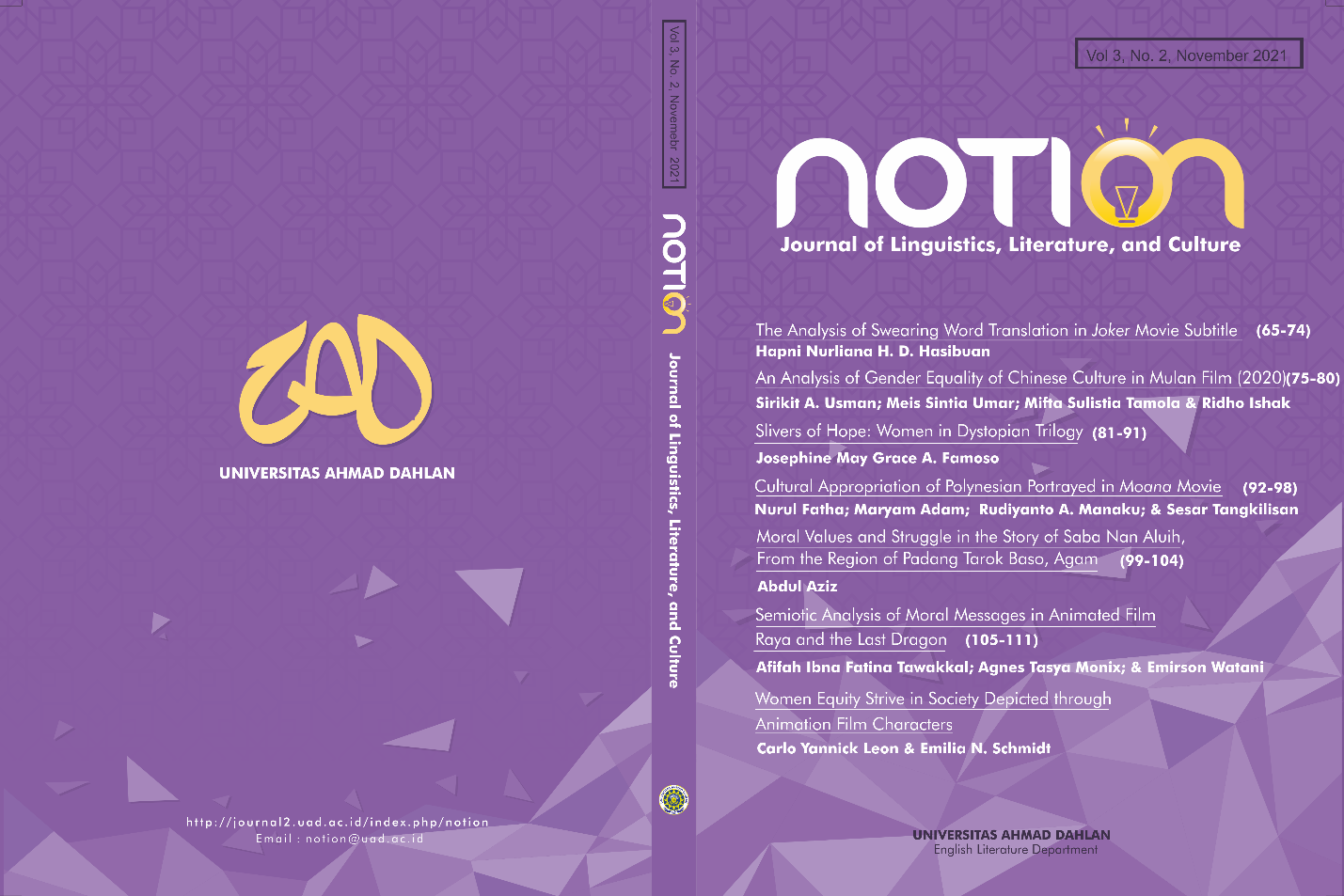The Analysis of Swearing Word Translation in Joker Movie Subtitle
DOI:
https://doi.org/10.12928/notion.v3i2.4852Keywords:
Translation, Swearing Word, Types of Swearing, Translation ProcedureAbstract
This research discusses the analysis of swearing words translation in the Joker movie. The purpose of this research is to describe the type of swearing word and the procedure used in translating swearing word. This study uses qualitative methods. The research data were obtained from English subtitles to Indonesian Joker movies. To answer the research question, the researcher used the theory types of swearing word proposed by Swan M. (1995) and procedure translation proposed by Newmark (1988) The results revealed that there were 49 swearing words. There are 2 types of swearing words namely: strong and weak swearing words. For strong swear words classified to exclamation of annoyance, surprise, insult, surprise question and emphasize the emotion and the weak swear word classified to exclamation of annoyance, surprise, insult and emotion. After that, procedures translation used in translating swear words only found 5 of 15 procedure translation in Joker's subtitle, namely: cultural equivalent, synonymy, through-translation, shift or transposition, and paraphrase. The most frequently type of swearing word is emphasize an emotion from strong swear word. Furthermore, the cultural equivalent procedure is the most used in translating.References
Andersson, L. & Trudgill, P. (1990).Bad language. Oxford: Blackwell.
Bell, R. T. (1991). Translation and Translating: Theory and Practice. London and New York: Longman.
Bernschütz, M. 2010. Empirical Study of Subtitled Movies. Translation Journal. Available at: http://accurapid.com/journal
Catford, J.C. (1965). A Linguistic Theory of Translation : An Essay in Applied Linguistics. Oxford: Oxford University Press.
Chuang, Ying-Ting.(2006). Studying Subtitle Translation From A Multi-Modal Approach.Babel, vol. 52,no. 4,pp. 372-383.
Cintas,Jorge Diaz dan Remael, Aline.(2014). Audiovisual Translation: Subtitiling.London&New York:Rouyledge.
Cronin, M. (2009). Translation goes to the Movies. London: Routledge, https://doi.org/10.4324/9780203890806
Dewi. B.I.K (2019). Swear words translation of Indonesian subtitle of Spy movie. Yogykarta : Universitas Sanata Dharma
Fägersten, K.B and Stapleton, K. (2017). Swearing research as variations on a theme.John Benjamins Publishing Company
Harvey, P. (2011, June 17). Why we swear. Eureka Street, p41-42
Hill, J. (2004). Swearing – Using Bad Words. South Australia: Women's and Children's Health ,Network.
Jensen, E.K. (2008). Translation and Translation Theory. University of Aalborg.
Lindahl, Katarina. 2008. “The X-word and Its Usage. Taboo Words and Swearwords in General, and X-words in Newspapersâ€. EstetiskFilosofiska Fakulteten. Karlstads Universitet. Retrieved on 01 January 2020, from http://www.diva-portal.org/smash/get/diva2:5732/FULLTEXT 01.pdf
Ljung, Magnus. 2011. Swearing: A Cross-Cultural Linguistic Study. London: Palgrave Macmillan
Moleong, L. J. (2001). Metode Penelitian Kualitatif. Bandung: PT Penerbit Remaja Rosdakarya.
Nababan, M., Nuraeni, A., & Sumardiono. (2012). Pengembangan model penilaian kualitas terjemahan. Kajian Linguistik dan Sastra, 24(1), 39–57.
Newmark, P (1981). Approaches to Translation, Oxford: Pergamon Press.
Newmark, P. (1988). A textbook of translation. London: Prentice Hall International.Ebook.
Nida, Eugene A. and Charles R. Taber. (1969). The Theory and Practice of Translation. Leiden:E.J. Brill
Nordquist, Richard. "What Are Swear Words and What Are They Used For?" ThoughtCo, Dec. 7, 2018, thoughtco.com/swear-word-term-1691888.
Sanders, L. (2009, January 8). Makes You Feel Better. Science News Vol. 176, Issue 3.
Spinney, L. (2007, December 22). The Science of Swearing. New Scientist Vol. 196, Issue
Stapleton, Karyn. 2010. “Swearing.†In Interpersonal Pragmatics, ed. by Miriam A. Locher & Sage L. Graham, 289‒306. Vol. 6 of Handbooks of Pragmatics, ed. by Wolfram Bublitz, Andreas H. Jucker & Klaus P. Schneider. Berlin: Mouton de Gruyter
Swan, M. (1995). Practical English usage. Oxford: Oxford University Press.
Venuti, L. (2008). The Translator's Invisibility: A history of Translation (Second Edition). London and Newyork: Routledge.
Vitasari, I. (2013) Analysis on The Translation of Swear Words Produced by Two Main Characters in A Very Harold And Kumar Christmas Movie. LANTERN (JOURNAL ON ENGLISH LANGUAGE, CULTURE AND LITERATURE) Volume 2, Nomor 2
Wijana, I Dewa Putu dan Muhammad Rohmadi. 2006. Sosiolinguistik: Kajian Teori dan Analisis. Yogyakarta: Pustaka Pelajar.
Downloads
Published
Issue
Section
License
Copyright (c) 2021 Hapni Nurliana H.D Hasibuan

This work is licensed under a Creative Commons Attribution 4.0 International License.
Authors who publish their articles in NOTION: journal of Linguistics, Literature, and Culture agree to the following terms:
- Authors retain the copyright and grant the journal right of first publication with the work simultaneously licensed under a Creative Commons Attribution 4.0 International License that allows others to share the work with an acknowledgement of the work's authorship and initial publication in this journal.
- Authors are able to enter into separate, additional contractual arrangements for the non-exclusive distribution of the journal's published version of the work (e.g., post it to an institutional repository or publish it in a book), with an acknowledgement of its initial publication in this journal.
- Authors are permitted and encouraged to post their work online (e.g., in institutional repositories or on their website) prior to and during the submission process, as it can lead to productive exchanges, as well as earlier and greater citation of published work.





